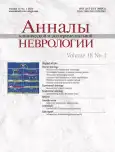PreventS-MD®: a New Digital Technology to Maintain Cardiovascular Prevention in Routine Clinical Practice
- Authors: Kravchenko M.A.1, Gnedovskaya E.V.1, Feigin V.L.1,2, Piradov M.A.1
-
Affiliations:
- Research Center of Neurology
- Auckland University of Technology
- Issue: Vol 18, No 1 (2024)
- Pages: 88-97
- Section: Reviews
- URL: https://journals.rcsi.science/2075-5473/article/view/255209
- DOI: https://doi.org/10.54101/ACEN.2024.1.10
- ID: 255209
Cite item
Abstract
Stroke, myocardial infarction (MI), and other main non-communicable diseases (NCDs) remain major causes of mortality and disability globally. Up to 80% of cardiovascular events and up to 60% of NCDs are associated with potentially controlled risk factors (RFs). State-of-the-art digital technologies can help bridge the gap between evidence-based prevention methods and their critically low availability in routine clinical practice.
An innovative digital platform named PreventS-MD® is a specially developed tool for healthcare professionals to be used under time constraints. With PreventS-MD®, clinicians can estimate patient's 10-year cardiovascular risk within several minutes. Then, they automatically get adapted results and recommendations to address identified RFs as well as graphical representation of specific RF contribution to overall stroke and MI risks. If some additional time is available, the clinician and the patient can collaboratively set customized achievable goals to correct modifiable RFs. An integrated analytical module provides healthcare managers with current digital risk profiles of the relevant population to evaluate prevention effectiveness and to forecast the load throughout the healthcare levels.
PreventS-MD® has several unique advantages, including time-saving design, the function to activate motivated RF correction, individually tailored recommendations, and information on personally changed digital profiles of vascular risks. As cardiovascular diseases and main NCDs have a lot of common RFs, PreventS-MD® implemented into routine clinical practice will utilize a complex approach to the prevention of main NCDs, decreasing both stroke and MI burden and addressing complications of chronic pulmonary and kidney disease, tumors of any type, dementia, etc.
Keywords
Full Text
##article.viewOnOriginalSite##About the authors
Mikhail A. Kravchenko
Research Center of Neurology
Author for correspondence.
Email: kravchenko@neurology.ru
ORCID iD: 0000-0001-5187-5518
Cand. Sci. (Med.), senior researcher, Institute of Medical Education and Professional Development
Russian Federation, MoscowElena V. Gnedovskaya
Research Center of Neurology
Email: kravchenko@neurology.ru
ORCID iD: 0000-0001-6026-3388
D. Sci. (Med.), Director, Institute of Medical Education and Professional Development
Russian Federation, MoscowValery L. Feigin
Research Center of Neurology; Auckland University of Technology
Email: kravchenko@neurology.ru
ORCID iD: 0000-0002-6372-1740
D. Sci. (Med.), Foreign member of the Russian Academy of Sciences, mail researcher, Director, National Institute of Stroke and Applied Neuroscience
Russian Federation, Moscow; Auckland, New ZealandMikhail A. Piradov
Research Center of Neurology
Email: kravchenko@neurology.ru
ORCID iD: 0000-0002-6338-0392
D. Sci. (Med.), Academician of the Russian Academy of Sciences, Director
Russian Federation, MoscowReferences
- Рассказова Е.И. Понятие саморегуляции в психологии здоровья: новый подход или область применения. Теоретическая и экспериментальная психология. 2014;7(1):43–56. Rasskazova E.I. The concept of self-regulation in health psychology: a new approach or scope. Theoretical and experimental psychology. 2014;7(1):43–56.
- Рассказова Е.И., Иванова Т.Ю. Мотивационные модели поведения, связанного со здоровьем: проблема разрыва между намерением и действием. Психология. Журнал Высшей школы экономики. 2015;12(1):105–130. Rasskazova E.I., Ivanova T.Yu. Motivational behaviors related to health: the problem of the gap between intention and action. Psychology. Journal of the Higher School of Economics. 2015;12(1):105–130.
- Фейгин В.Л., Варакин Ю.Я., Кравченко М.А. и др. Новый подход к профилактике инсульта в России. Анналы клинической и экспериментальной неврологии. 2017;9(4):19–23. Fejgin V.L., Varakin Yu.Ya., Kravchenko M.A et al. A new approach for stroke prevention in Russia. Annals of clinical and experimental neurology. 2017;9(4):19–23. doi: 10.17816/psaic84
- Медик В.А., Осипов А.М. Общественное здоровье и здравоохранение: медико-социологический анализ. М.; 2012. Medik V.A., Osipov A.M. Public health and healthcare: a medical and sociological analysis. Moscow; 2012.
- Burack R.C. Barriers to clinical preventive medicine. Prim. Care. 1989;16(1):245–250.
- Eriksen C.U., Rotar O., Toft U.N. What is the effectiveness of systematic population-level screening programmes for reducing the burden of cardiovascular disease? WHO Regional Office for Europe, 2021.
- Gmeinder M., Morgan D., Mueller M. How much do OECD countries spend on prevention? Organisation for Economic Co-Operation and Development; 2017. doi: 10.1787/18152015
- Kottke T.E., Brekke M.L., Solberg L.I. Making "time" for preventive services. Mayo Clin. Proc. 1993;68(8):85–91. doi: 10.1016/s0025-6196(12)60638-7
- McPhee S.J., Richard R.J., Solkowitz S.N. Performance of cancer screening in a university general internal medicine practice: comparison with the 1980 American Cancer Society Guidelines. J. Gen. Intern. Med. 1986;1(5):275–281.
- Spitz M.R., Chamberlain R.M., Sider J.G. et al. Cancer prevention practices among Texas primary care physicians. J. Cancer Educ. 1992;7(1):55–60. doi: 10.1080/08858199209528142
- Wender R.C. Cancer screening and prevention in primary care. Obstacles for physicians. Cancer. 1993;72(3 Suppl):1093–1099. doi: 10.1002/1097-0142(19930801)72:3+<1093::aid-cncr2820721326>3.0.co;2-b
- Feigin V.L., Krishnamurthi R., Medvedev O. et al. Usability and feasibility of PreventS-MD web app for stroke prevention. Int. J. Stroke. 2024;19(1):94–104. doi: 10.1177/17474930231190745
- Feigin V.L., Martins S.C., Brainin M. et al. Twenty years on from the introduction of the high risk strategy for stroke and cardiovascular disease prevention: a systematic scoping review. Eur. J. Neurol.2024;31(3):e16157. doi: 10.1111/ene.16157
- Parmar P., Krishnamurthi R., Ikram M.A. et al. The Stroke RiskometerTM App: Validation of a data collection tool and stroke risk predictor. Int. J. Stroke. 2015;10(2):231–244. doi: 10.1111/ijs.12411
- Feigin V.L., Norrving B., Mensah G.A. Primary prevention of cardiovascular disease through population-wide motivational strategies: insights from using smartphones in stroke prevention. BMJ Glob. Health.2016;2(2):e000306. doi: 10.1136/bmjgh-2017-000306
- Lloyd-Jones D.M., Hong Y., Labarthe D. et al. Defining and setting national goals for cardiovascular health promotion and disease reduction: the American Heart Association's strategic Impact Goal through 2020 and beyond. Circulation. 2010;121(4):586–613. doi: 10.1161/CIRCULATIONAHA.109.192703
- Ogunmoroti O., Allen N.B., Cushman M. et al. Association between Life's Simple 7 and noncardiovascular disease: the multi-ethnic study of atherosclerosis. J. Am. Heart Assoc. 2016;5(10):e003954. doi: 10.1161/JAHA.116.003954
- Wilson P.W., D'Agostino R.B., Levy D. et al. Prediction of coronary heart disease using risk factor categories. Circulation. 1998;97(18):1837–1847. doi: 10.1161/01.cir.97.18.1837
Supplementary files
















